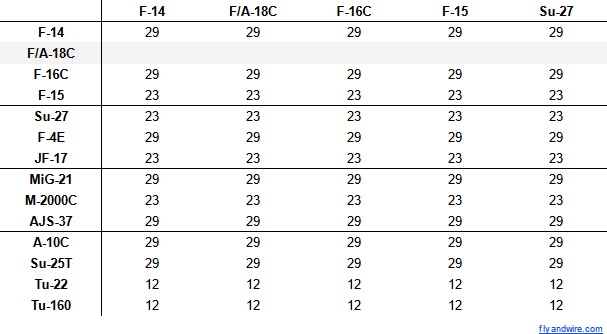DCS and Electronic Countermeasures: Table of Contents
- Part I: Electronic Countermeasures – Introduction
- Part II: F-14 Avionics
- Part II: Missile Employment
Now that we know how to identify a jamming aircraft and how to determine or approximate its range, we can finally focus on engaging it.
A recap of the issues affecting DCS, leading to the conclusion that DCS is indeed a poor combat simulator, is available in this article.
Home-On-Jam
HOJ is probably a familiar acronym nowadays (nevertheless, that confused me a lot when I was a kid as I couldn’t grasp the relation between marmalade and buildings, but eventually, I figure it out…).
Some modules, such as the FC3 F-15C, show a very visible indication of this mode.

A missile employed in Home-On-Jam mode guides itself autonomously and aims for the source of the jamming signal. Although in real life its efficacy is debatable, in DCS it works fairly well.
As we know, some missiles are guided by their respective WCS through complex arcuate trajectories (“loft”). The objective is trading energy, provided by the rocket motor, into altitude and then, when the rocket motor is exhausted, gain back energy whilst the missile dives onto the target. Fundamental for this technique to work is the range between the shooter and the target. Unfortunately, this is the parameter the depicted noise jammers try to deny. As we have seen in Part II, however, we can assess the range through different methods, and we can predict the performance of the missile when lauched in this mode.
A “pure”, unassisted, HOJ is quite rare, however, as the vast majority of the missiles need to loft to be a threat at 30+ nautical miles. Most of the time, if we play by the rules that no one follows, the target will be closer than burnthrough range at launch, de facto annulling the negative sides of jamming, and leaving only the positive.
Burnthrough Range Comparison
As the table below shows, not all aircraft appear on the scope at the same range.

Yes, the numbers are oddly similar..
Taking the Shot (and Breaking the Rules)!
Since angles and elevation are provided or obtainable, and by assessing the range, the crew has the basic information it needs to determine the feasibility of a missile launch.
Radar modes: Track-While-Scan
Anecdotal evidence suggests that the WCS fared well against blinking noise-jammers. In DCS, the WCS is indeed capable of using a clear range reading to command the loft of the missile, and then it maintains and adjusts the guidance switching between JAT and PD as the target becomes visible again.
Testing this scenario is simple, and crews can notice how, past burnthrough range or if the target’s ECM is disabled again, the WCS updates the TTI. However, presently, it seems that the missile guidance is not properly adjusted, possibly due to the limitations of the missile implementation. It is a big problem, however, as any aircraft can defeat a TWS launch just by toggling their ECM on and off.
Tossing the AIM-54 Phoenix
The lack of automated loft trajectory guidance means that the crew has to find another solution, not necessarily realistic: the pilot can, in fact, manually make the missile loft by pitching up sharply before releasing the missile. This is nothing new, and it has been possible since forever in DCS, probably LOMAC too. When it comes to the F-14 Tomcat, manual loft was not needed before the recent patch that drastically changed the AIM-54 Phoenix and, in normal conditions, it is still not as fundamental as it is in the scenario being discussed.
The manual loft can also be a means of harming the performance of the missile. The WCS guidance logic, in fact, does not work well when a Phoenix is over-tossed, causing the trajectory to arc too much, and resulting into an inefficient investment of energy into altitude.
Therefore, the crew has to assess the most appropriate angle for the loft very carefully.
The AIM-7 Sparrow study has shown how the most efficient loft angle was equal to the range, in absolute terms. For example, at 30 nm, a 30° was the most efficient angle, after which there was still a gain, but at a lower ratio. In other words, pulling harder meant ending in the diminishing returns area. For the AIM-54 the matter is slightly more complicated, and the pull angle should not exceed, in standard scenarios, 35°/40°. Otherwise, the trajectory will become almost vertical and perpendicular to the direction of the AIM-54. Imagine a goalkeeper messing up and throwing the ball almost vertically upwards: most of the energy will be wasted in the climb, but with little gain in on the horizontal plane.
The King: JAT/PD STT
An PD STT lock to a jamming target transitions into JAT STT, and it is capable of providing angular guidance to the AIM-54, which will then rely on the energy traded for altitude through the manual loft to cover greater distances.
However, the trick is piercing through the burnthrough range whilst the missile has completed the climb. This results in the WCS automatically switching from angle tracking to PD STT, resuming proper guidance and adjusting course. If the AIM-54C is used in this phase, the missile can also be activated willingly or by the target breaking the lock.
It is important that the RIO familiarise with the topics discussed in Part II before attempting this type of engagement.

Since firing in angle-tracking mode forces HOJ, which in turn forces a flat trajectory, the crew has to pull quite hard on the angles. Usually, for a target at 45-50+ an angle between 35° and 40° works, depending on the geometry. Altitude and speed are critical too, but this is true across every employment method of the AIM-54 Phoenix.

However, be very aware of the burnthrough range: if the manual loft is initiated and the target suddenly were to enter the burnthrough range (or turn off the ECM), the AIM-54 will following a very steep loft angle, wasting most of its energy.
See the image below, and compare it to the previous.

AIM-7 Sparrow HOJ
Subject of a recent study, some versions of the AIM-7 support HOJ. However, in this mode, the Sparrow does not loft, neither automatically nor manually.

This is not a great problem for the missile, as its max range is somewhat close to the average burnthrough range.
(For the record, I have tested the AIM-120 as well, and it behaves as the AIM-54, but it is more limited by the shorter burn time of its rocket motor).
Video
Five practical examples, showing different threats, ranges, and even mistakes (Example III shows the effect of overlofting), can be found in this video.
The first part is a discussion about the issues and limitations of DCS, which push us to find a solution when the realistic option is not available.
